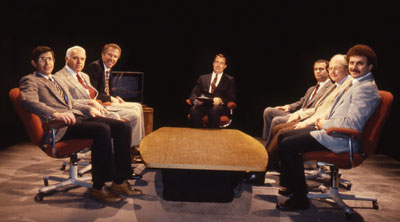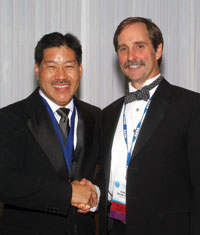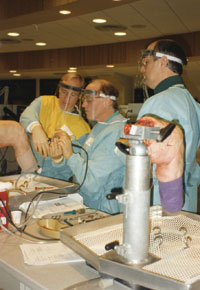The Arthroscopy Association of North America evolved with the times, but retained a commitment to education
The organization is currently working on technological advances in CME education and laboratory models for teaching arthroscopy.
In 1981, the founders of the Arthroscopy Association of North America set out to establish an organization that would serve to educate orthopedic surgeons in arthroscopy, a controversial technique at that time.
Now celebrating its 30th anniversary, the Arthroscopy Association of North America (AANA) remains focused primarily on education while working to meet the changing technology needs of its members.
“The basic mission was to advance education in arthroscopy and that has not changed at all,” Felix H. Savoie III, MD, of New Orleans, current AANA president, told Orthopedics Today. “However, the application of arthroscopy has changed immensely during the last 30 years.”
Membership in AANA has grown from 600 to more than 3,000. Arthroscopy itself has evolved from a solely diagnostic technique to one that surgeons now use in one-third of all orthopedic procedures, according to the AANA website. “Every joint … can be viewed arthroscopically,” said Jack M. Bert, MD, of St. Paul, Minn., AANA president in 2008-2009 and an Orthopedics Today Editorial Board Section Editor. “The shoulder, elbow, hand, wrist, hip, knee, ankle and even the big toe have been viewed arthroscopically, and these were all techniques originated and taught by [AANA].”
|
Image: Johnson LL |
A rough start for arthroscopy
However, arthroscopy was not always so widely accepted. “Who was most against arthroscopy as an idea when it first started? The answer is the vast majority of professors or chairmen of orthopedic departments and, ironically, the sports medicine doctors of the day,” Lanny L. Johnson, MD, an AANA founder, told Orthopedics Today. “[Those of us] interested in arthroscopy had to do something on our own, because the mainstream wasn’t going to accept this at the university, state or sports medicine level.”
In fact, according to Johnson, although arthroscopy was introduced in North America around 1969, only half of orthopedic surgeons in 1982 thought the technique had merit.
|
Image: Johnson LL |
Some even referred to arthroscopy as the “tool of the devil,” according to J. Whit Ewing, MD, an AANA founder, past president, and currently the executive vice president of AANA. He first encountered arthroscopy in a monograph he spotted in the doctors’ lounge at his hospital in 1971. The hospital he worked for at the time would not buy arthroscopy instruments, so he purchased his own with help from the partners at his practice.
“I was frustrated because we were making large incisions, looking in the knee, seeing portions of things but not really knowing what we were looking at because it was too difficult to see and there were too many structures,” Ewing told Orthopedics Today. “With a small scope, you can slip past those things and just see exactly what is wrong.”
Ewing spent every day for 6 weeks arthroscoping cadavers and in the process trained himself in how to introduce the arthroscope into the knee. In 1972, he performed arthroscopy on his first patient. Before the procedure, Ewing believed the patient had torn inside cartilage. “To my amazement, when I looked at his knee, it was normal — except, when I looked outside the meniscus, it was torn,” he said. “I knew right then and there that I would never open another knee … I knew we were on the cutting edge of a changing paradigm in orthopedic surgery.”
From IAA to AANA
As interest in arthroscopy grew, Ewing, Johnson and others joined the International Arthroscopy Association (IAA) formed by John Joyce III, MD, and others in 1972. At the time, the IAA president was Masake Watanabe, MD, who performed the first arthroscopic meniscectomy in Japan in 1962 and taught the technique to several surgeons, including Robert W. Jackson, MD, of Toronto, who is credited with bringing arthroscopy to North America.
|
Image: AANA |
Image: Johnson LL |
The IAA North American chapter was the largest by a substantial number, according to Ewing, and the educational needs of North American arthroscopists were growing. So, during the triennial meeting of the International Society of Orthopedic Surgery and Traumatology in Rio de Janeiro in 1981, Joyce, Jackson, Alan Bass, MD, and Ralph Lidge, MD, decided an independent association was needed. AANA was born.
Highlights in AANA’s history
John McGinty, MD, editor in chief emeritus of Orthopedics Today, presided over the first AANA meeting in Chicago on May 5, 1982. In 1983, AANA established Arthroscopy: The Journal of Arthroscopy and Related Surgery. According to its website, the journal is currently ranked eighth out of 56 orthopedic journals on the 2010 Journal Citation Reports.
As members’ interest in psychomotor-skills education increased, AANA introduced the idea of a hands-on course in 1983. “This was back in the day when people were not allowed to use cadavers because we had just learned about AIDS,” Ewing said, noting courses were started where only the faculty was allowed to demonstrate procedures on cadaver parts.
When Ewing became the chairman of the education committee, he significantly changed the format of the fall course to involve hands-on motor-skills training using cadavers. As the popularity of hands-on training grew, AANA’s leadership laid out plans to build an orthopedic learning center, which was championed by Howard Sweeney, MD. The development of the orthopedic learning center spanned three presidents: Douglas W. Jackson, MD, in 1991, Ewing in 1992, and Dilworth W. Cannon, MD, in 1993. AANA decided to rent space from the American Academy of Orthopedic Surgeons (AAOS) for the orthopedic learning center and also entered into a partnership with AAOS.
The resultant board of directors, with equal representation by AANA and AAOS members, oversees the governance of future psychomotor-skills training. Since the learning center opened in 1994, AANA members have trained more than 10,000 surgeons worldwide.
“It was my goal when I was president to launch the ship — in other words, to land it, to get the learning center working, to get all the work done, to get it incorporated,” Ewing said. “It was a great day when I was able to put my signature on the agreement with AAOS.”
|
Image: AANA |
AANA’s future direction
AANA is now adjusting to the digital world by developing CME education opportunities online and is producing its first electronic issue of Arthroscopy, which will include videos and demos, Ewing said. According to Savoie, the organization created a website with community modules and is developing an “app” to make its program Smart Phone friendly.
However, with industry representatives training surgeons on their products at their own laboratories, AANA is facing new challenges. “This is a huge problem … because you lose the unbiased, what I consider honest approach to training people in the best way to do something without being prejudiced toward a specific product line,” Bert said.
To further complicate matters, physicians have to bear the cost to attend an AANA course in tough economic times with declining reimbursements. Bert said AANA’s approach to this problem is “to offer a course that’s up to date and cutting edge, uses the best instructors in the country and offers an unbiased approach in how to treat a problem.”
AANA leadership has also taken on a new project dubbed the Magellan Project, which involves testing new models for teaching arthroscopic techniques. It is headed by incoming president Richard Angelo, MD, according to Bert. For example, Rob Pedowitz, MD, PhD, of UCLA, has looked at material that duplicates human tissue and joints and can be used as testing models in place of the more expensive cadavers.
“Doctors can learn arthroscopy in a laboratory environment where a product can be used over and over again, but it would be a realistic teaching product so that those physicians would be qualified to operate on patients,” Bert said.
The organization’s accomplishments and future endeavors have all been done in the name of education, and Ewing and others who were there from the beginning are satisfied with where things are headed. “To see where arthroscopy is going now — and going in the right direction — is wonderful,” Ewing said. “I felt very privileged to be part of that generation [of founders].” – by Tina DiMarcantonio

- Jack M. Bert, MD, can be reached at 17 W. Exchange St., 307 Gallery Medical Building, Saint Paul, MN 55102; 651-223-9204; e-mail: bertx001@tc.umn.edu.
- J. Whit Ewing, MD, can be reached at 330-701-4863; e-mail: Jwhitewing@aol.com.
- Lanny L. Johnson, MD, can be reached at P.O. Box 975, Okemos, MI 48805-0975; 517-285-1812; e-mail: lljmd@aol.com.
- Felix H. Savoie III, MD, can be reached at Tulane University School of Medicine, 1430 Tulane Ave., Room 2070, Department of Orthopedics, New Orleans, LA 70112-2699; 504-988-5770; e-mail: BuSavoie@aol.com.





